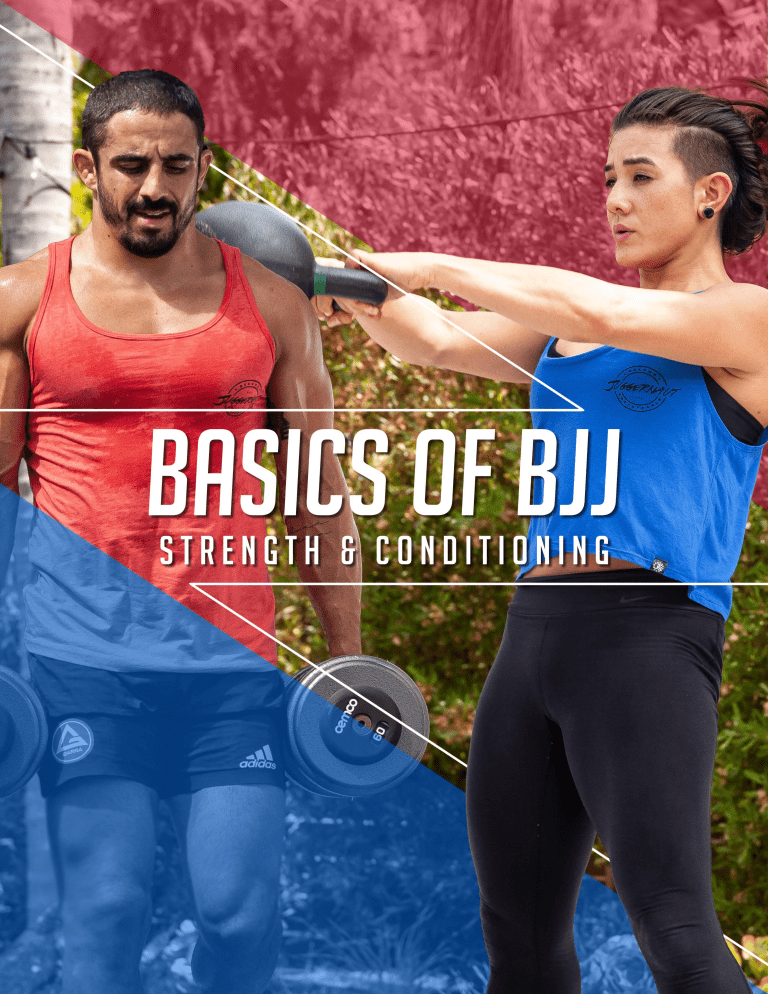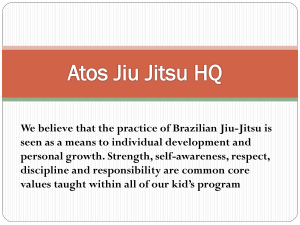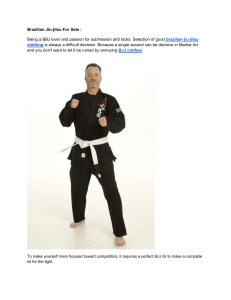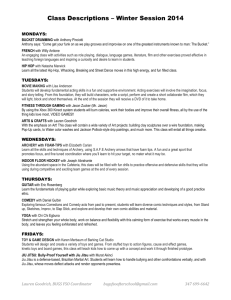
Basics of BJJ Strength & Conditioning Training for the sport of Brazilian Jiu-Jitsu presents many unique challenges to the athlete, as they must use their finite time and energy efficiently to develop a wide array of technical, tactical and physical characteristics. One of the things that makes Jiu Jitsu appealing to so many people is that there are so many different body types and physical skills that can be a path to success, different games may rely more on strength, speed, flexibility or endurance, there are great practitioners who are slow and methodical, while others succeed through their dynamic athleticism and explosiveness. Organizing BJJ & Strength Training When beginning to plan your Strength & Conditioning training, you first must assess what your needs as an athlete are. What are the demands of the sport? Every practitioner should prioritize: 1. BJJ Skill 2a. Strength/Power 2b. Enduranc - The endurance for a match in a tournament but also the capacity to train 2c. Mobility/Flexibility The priority of 2a, 2b, 2c is determined by the athlete’s style and what they currently lack. Once you establish how you need to distribute your efforts to the different physical qualities, you need to assess where your level of commitment is to the sport. Serious Competitor - Competing multiple times per year in high level competition. Casual Competitor - Competing a few times per year locally, likely in a Masters division Recreational Practitioner - Training at your local school to improve your skills and fitness. The level at which you hope to compete will be significant in helping determine how much energy is placed to different aspects of your training and the volume of your different training loads. The next piece of helping us organize your training is identifying your training history. If you haven’t done much before/aren’t doing anything currently, a little will go a long way. If you are already very well developed in one area (strength, speed, endurance, flexibility) you can stay at more maintenance volumes there. This pertains to BJJ skill as well-if you’re a brown belt with no GPP background, you aren’t gonna forget how to do Jiu Jitsu by going from 6 sessions/week to 4 sessions/ week and adding in 2 GPP sessions. Injury history is also a significant piece to understand here. Now that you better understand what you need, we can begin to organize your training week, this process begins by classifying your different training efforts into High, Medium and Low Intensity Stressors. CLASSIFICATION OF STRESSORS Our goal in identifying these stressors is to arrange them throughout the week to help facilitate recovery. This can have different configurations through different times of training but the general idea is that you want to organize High Intensity stressors together, so that the other days can be lower stress and help facilitate recovery. Some examples of different organizations may look like this: While being able to organize your stressors into a strategic Hi/Low sequence is ideal, I understand that life happens and schedules have limits, so keep in mind that while Hi/Low sequencing is best, creating a plan that you can actually follow is most important. Don’t get frustrated by thinking that you can’t do an ideal lifting plan to complement your training and in turn, don’t do any strength training, that would be a mistake. Some training, even if it isn’t optimal, is better than none. To get a better understanding of the principles that should guide the organization of your training, check out this video: Periodization for BJJ Strength & Conditioning The next critical aspect to maximizing your BJJ performance through Strength & Conditioning is periodizing your plan to ensure maximal performance at your next competition and over the long term. A properly periodized plan (say that 5x fast) for Jiu Jitsu will begin with understanding the energetic demands of Jiu Jitsu and understanding how to prioritize training for those. There are four energy systems that will be most impactful: Aerobic Capacity This is what many would refer to as your ‘gas tank’, this is your ability to utilize oxygen as your main fuel source and will impact your ability to perform during a match and to recover between matches in a tournament, as well as increasing your capacity to train more in a given session and recover better between sessions. Alactic Power This is your highest possible output in a single effort. How fast can you shoot, how hard can you bridge, how much can you explode through a position or escape? While being able to sustain and repeat efforts is important, if the most powerful you can be, isn’t powerful enough to execute your needed movement, it doesn’t matter how many times you can repeat it. Alactic Capacity This is how well you can repeat high level efforts. For example, if your best Box Jump is 45” that is your Alactic Power and you ability to do as many 40” box jumps with 10 seconds rest between reps would be your Alactic Capacity. Extend this idea to your ability to shoot for takedowns repeatedly, scramble to position or any other explosive aspects of grappling. Lactic Capacity Finally, this energy system encompasses your ability to sustain high level efforts for extended periods of time. This is particularly evident during long periods of high tension during a match, like trying to finish a submission, maintain your guard or finish a hard fought pass. Think of this as intense work that is 30 seconds or more of continuous work. Now that we have some understanding of what these different Energy Systems are, we can look at how to pair them with your Strength Training and move from less specific to competition success to more specific to competition success over time. Please note that Aerobic Capacity Training is omnipresent through all phases of training. Phase 1 More frequent, less intense training in the weight room and on mats so that you can build work capacity for subsequent phases. This means submaximal weights and BJJ training biased towards more drilling and specific training. Weights - 55-80% for Sets of 4-8 Reps for 24-100 Reps/Weekly for each primary movement. Squat, Upper Body Press, Hip Hinge/Ext, Upper Body Pull. 1-3 sessions of each weekly. - Upper body lifts can generally handle more volume at relatively higher intensities but exercise selection and injury history will influence this significantly. - Stronger/more experienced lifter you are, you can tend to the lower ends of the %s - Controlled rest periods are a good option to control your time in the weight room and build capacity - Accessory work in 12-20 rep range to support hypertrophy, joint health and local muscular endurance. Alactic Power - Sprints: 50-100m of volume 1-2x/week. 30 seconds rest for every 10m of sprinting. Sled, hills or stairs are a good option to mitigate risk of soft tissue injury. - Jumps: 20 to 60 contacts/week over 2-3 sessions. Jumps onto a box or up stairs are good for reducing forces in the landing. Jumps for distance will have higher carryover to shots. - Throws: 50 to 100 total throws/week over 1-2 sessions. Great for building power in multiple directions w/ low stress on the joints. Easy to learn. Speed of throw is more significant than weight of ball. Phase 2 More undulation of sessions during the week to some higher intensity work and other lower intensity. Slightly less frequent strength training to allow for higher intensity per session and more recovery built in to the structure of the week. Maybe rel- egating lower intensity work (accessory movements) to separate sessions aimed at recovery. Consolidation of Stressors. Work on mats is intensifying as well to more specific and live training in a few sessions while other sessions are still lower intensity drilling and flow rolling. Weights - 70-90% for Sets of 2-4 Reps. 12 to 48 Reps/Weekly for each primary movement. 1-2 sessions of each weekly. - Accessory work in 8-12 rep range to support hypertrophy and joint health - Accessory work in 12-20 rep range to support hypertrophy, joint health and local muscular endurance. alactic capacity - Special Strength Exercises. Movements that mimic the direction, duration and velocity of sporting movements or movements that use the same muscles with the same systems. - Example Movements Jumps: KB Squat Jump, Clapping Pushups, Split Jumps, MB Chest Pass Rebounds Throws: MB Slams, MB Rocket Throws, MB Scoop Throw Twisting: BB Twists, MB Side to Side Slams, Band Resisted Judo Throws Pulling: KB/DB Drop Rows, 1 Arm Rope Rows, Clapping Pullups Isometrics: Deadlift Isometric into Rack, Bench Isometric into Rack Other: KB/DB Snatches, Band Resisted Swings, Sandbag Shouldering - 3 to 6 seconds of maximal effort with 10-20 seconds of rest for 4 to 12 sets per exercise. 4 to 8 exercises total. - How I set the clock Phase 3 Slightly less frequent hard training because training is more fatiguing. Hi/Low concept. BJJ Sessions are a mix of intensive sessions focused on live rolling and specific training (positional rolling) with other sessions dedicated to drilling and submaximal training. Weights - 60-85% for Sets of 1-3 Reps for 6 to 30 reps weekly for each primary movement. 1-2 sessions of each weekly - Accessory work in 6-10 rep range to support hypertrophy and joint health lactic capacity - Special Strength Exercises and Cyclical Movements (these lend themselves well to constant effort for lactic capacity) - 20 to 40 seconds of maximal effort with 20 to 40 seconds of rest (active rest depending on fitness) for the length of your competition matches. Watch this video to learn more about creating an effective Phasic Structure for Jiu-Jitsu Strength Training: One question that is always hotly debated in Jiu Jitsu training circles is how much strength training is useful for Jiu Jitsu or how heavy do you need to lift for BJJ? “Technique beats strength” All things being equal, the person with the better technique wins...or all things being equal the stronger person wins, but all things are never equal. Strength is the ability to produce force but Maximal Strength is only a part of the way strength is expressed for BJJ Maximal Strength Explosive Strength Isometric Strength Strength Endurance The strongest BJJ competitors are nowhere near the strength levels of comparable level (think if there was a belt system for Powerlifters, etc) strength athletes, football players, track & field athletes (sprinters/throwers), probably not even gymnasts. The level of strength needed to excel in BJJ will be the byproduct of well designed training, not the objective of it. You don’t need to go on a Powerlifting program for BJJ. Maximal strength training comes with higher neurological fatigue and joint stress. You can get strong enough with more submaximal work done with great intent, paired with explosive work, isometric training and higher reps for strength endurance that will also support Hypertrophy. Learn more about my insights on this topic in this video: Exercise Selection for BJJ Training What are the best exercises to train for Jiu Jitsu? This is one of the most common questions I receive in regards to training and the answer to it is in some ways more simple than it seems and in some ways more complex. The core of the answer is that there are no best exercises for Jiu Jitsu, or any oth- er non-barbell sports for that matter, so the first step in having an effective discus- sion about this topic is to understand that. Rather there are movement patterns that are important to develop for success and there are principles to guide your decision making within the category of each of those patterns. The 6 most important movement categories to train for Jiu Jitsu are: Squat Hip Hinge/Extension Upper Body Pressing Upper Body Pulling Twisting Carrying When choosing which exercises within these categories are best for you at this point in your training, let these three questions guide you. Can the athlete perform the exercise safely? If your technique isn’t sound or you are limited by a previous injury, then that exercise isn’t for you. While High Bar Back Squats are tremendous for developing lower body strength, power and stability, they may not be right for some athletes with low back issues or lack of experience, so in those cases a Box Squat, Belt Squat or Goblet Squat may be more useful. Can the athlete create significant output on the exercise? You are in the weight- room to teach your body to produce more force, so you exercise selections should reflect this. While something like an Overhead Squat is a great display of mobili- ty throughout the body, it is typically inferior to something like a front squat because not as much weight can be used. How well does the exercise fit into the bigger structure of the plan? Conventional Deadlifts are a tremendous movement to build strength throughout the body but for an athlete who is training BJJ 6+ sessions per week or is a week or two away from a big competition, a movement that is so physically and neurally taxing may not be the right choice, so performing Block/Rack Pulls could be the smarter choice. Learn more about strategically selecting exercises for Jiu Jitsu performance in this video: Hopefully this all has helped you gain a better understanding of how to begin your Strength & Conditioning training to improve in Brazilian Jiu Jitsu. Here are some other resources to help you along the way, and of course we have our JuggernautAI BJJ Strength & Conditioning program that you can utilize that will take all of these factors into account in making a totally customized program for you. JuggernautAI’s newest system for BJJ Strength & Conditioning comes from the mind of Chad Wesley Smith, who has served as Physical Performance Coach to some of the World’s best Jiu Jitsu competitors like Romulo Barrall, Felipe Pena, Otavio Sousa and more. This system will help you develop Strength, Speed, Power, Endurance and Athleticism that is scaled appropriately for your age, experience and abilities.





